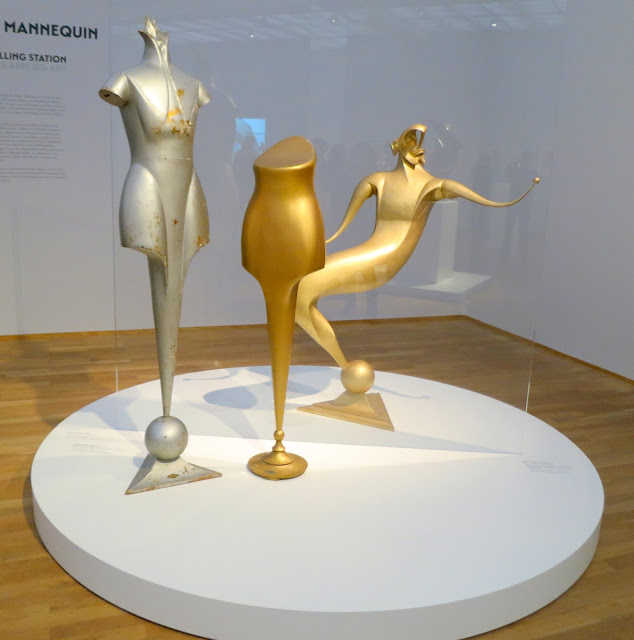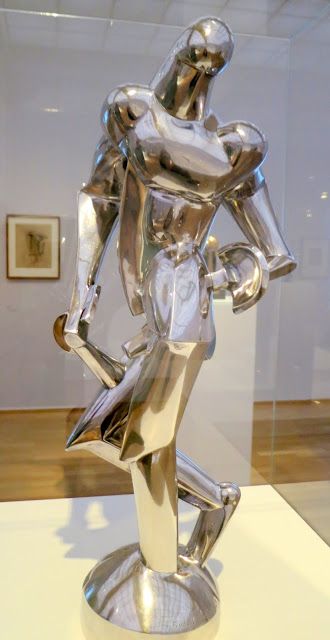When we were in Berlin quite a few months ago now, we visited lots of galleries and saw some wonderful art. I did not have the time to write it all up, but I am now trying, very slowly and when I have the time, to make a record of what we saw. This exhibition on the work of Rudolf Belling was one I thoroughly enjoyed, particularly since I was not familiar with his work.
Rudolf Belling
at Hamburger Bahnhof - Museum fuer Gegenwart, Berlin.
Belling was one of the most important German sculptors of classical modernism. His artistic creation, spanning six decades, was shaped by a unique variety: his stylistic vocabulary ranges from expressionism to new objectivity, futurism to constructivism, abstraction to naturalism. He worked as a stage designer, a costume designer, an architectural and advertising sculptor, a portraitist and a designer. In collaboration with architects he created interiors, architectural sculpture, fountains and monuments. His fashion sculpture is still considered today an outstanding example of the modern mannequin. 'Whether figurative or abstract, I give myself permission to do anything that seems necessary to form in an organically sensible way', the artist wrote in 1922. The principles of the 'Belling System', as he called it, include a conception of sculpture as seen from many different perspectives and the inclusion of empty space as an elementary compositional element.
Pilot, 1917, (aluminium)
Fashion Sculptures, 1921
Belling designed avant-garde window display figures for the factory Erdmannsdorfer Buestenfabrik. Introduced to the public as 'Modern-Plastiken', in 1921, they caused a sensation. They were made from varnished papier mache but in all their modernity they were dubbed goddesses of aluminium. Belling's fashion sculptures anticipated Art Deco aesthetics.
This model was used to present skirts and corsetry.
Two abstract heads were available for this model, to be fitted onto the bud-shaped neck; arm pieces could be short or long.
Triad, 1919
Head in Mahogany, 1921
Portrait of Joseph von Sternberg, 1930
In 1929, film director Joseph von Sternberg came to Germany from the US to shoot the film Der blaue Engel. Belling helped him in his search for a female protagonist. The part was given to Marlene Dietrich who subsequently gained international fame.
Organic Forms (Striding Man), 1921, (bronze)
Sculpture 23, 1923, (bronze)
Head in Brass, 1925
This female portrait radiates cool elegance that anticipates the aesthetics of the machine age and the Art Deco Style. With its android-like clear cut features, the Head in Brass could be seen as direct precursor of the machine woman from Fritz Lang's classic movie Metropolis. The droid C3PO from George Lucas' Star Wars saga might be inspired by it. The Head in Brass is one of the masterpieces of modernism in Germany, but nevertheless for a long time art criticism was divided about how to judge this cross between technoid futurism and female gracefulness that characterises the polished surfaces of this work.

Miner, 1930
The ethos of the working-class movement is conveyed by this larger-than-life miner from the foyer of the head office of the Rechsknappschaft, the occupational pension and health insurance organisation for miners.
A number of Belling's works were melted down by the Nazis.
Man and Woman (standing figures of the table sculpture Gemeinsamkeit), 1930-32, (bronze)
The two figures were originally part of a sculpture (now lost) for the reading table in the foyer of the publishing house De Arbeiderspers in Amsterdam, In it, the tree of life grew from a globe surrounded by waves in front of which stood the man and woman holding hands as a symbol of community.
Symbolic Shield, 1926/29, (bronze)

Fountain for Haus Goldstein, 1978
In 1922 the lawyer Ismar Goldstein commissioned Arthur Korn to build a modern villa, and by 1924, it was finished in Berlin's west end. For the terrace facing the gardens designed by Richard Neutra, Rudolf Belling created a fountain sculpture with moving parts The constructivist shapes make reference to the villa's architecture. The revolving spirals of the garden fountain make it an early form of kinetic modern art. However, it was dismantled in 1925. After 1933, the villa was expropriated. Goldstein died in 1942 in the Riga ghetto. The building was torn down during the post-war period.
Design for a filling station in Halle ander Saale, 1923
The innovative 1923 design for a filling station resulted from the collaboration of Belling, Gellhorn and Knauthe: a sculptor, an architect and an engineer. In the 1920s when the German motorway network was first being developed, the roofed-over filling station was an all-new building typology. The OLEX neon sign further emphasised its modernity. The structure however, was never built.
Max Schmeling, 1929, (bronze)
Design for a fountain in the garden of the Technical University of Istanbul, 1956, (bronze)
With the support of architect Hans Poelzig, Belling got a teaching assignment in Istanbul. He had to abandon his studio in Berlin as well as numerous works. Emigrating was the right decision, because in 1937, when the National Socialists presented their defaming propaganda show Degenerate Art at the Hofganrtenarkaden in Munich, Belling was represented by two works, the Triad and the Head in Brass.
Mask of an Orator, 1959, (bronze)

Symbol of Community, 1966-67, (bronze)
Primordial Animal, 1969, (bronze)
Design for a Relief, 1967
Relief with Seated Woman, 1946, (bronze)
Sculpture 49, (bronze)








































No comments:
Post a Comment